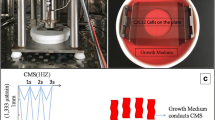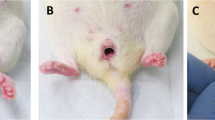Abstract
A sudden rise in intra-abdominal pressure that causes the pressure in the bladder to rise during physical movement and/or activity, such as coughing, sneezing, laughing, running, or weightlifting, is known as stress urinary incontinence. This condition causes an uncontrollable overflow of urine. The study’s goal was to determine whether effector molecules, specifically ADP ribosylation factor GTPase activated protein 3, might play a part in the female pelvic floor muscle’s ability to heal after suffering damage during vaginal delivery. Pelvic floor muscle samples were taken from women who had at least one vaginal delivery and were enrolled in either the IU group (n = 45; issue of stress urinary incontinence) or the NL group (n = 85; no issue of stress urinary incontinence) depending on whether they had a problem with stress urinary incontinence. Vesicle transport-related genes in female pelvic floor muscle injury repair were discovered using Gene Expression Omnibus. For gene analysis and screening, RT-qPCR was employed. On the first day following injury, the expression level of ARFGAP3 mRNA increased by 2.8 times (p 0.05) and by 5 times (p 0.01) on the third day. On the first day following damage, STMN1 mRNA expression rose by 0.3 times (p 0.05). On the first day following injury, the expression level of THBS2 mRNA increased by 1.6 times (p 0.01). On the third day following the injury, the expression level of PLXNB2 mRNA increased by 1.2 times (p 0. 01), and on the fifth day following the injury, it increased by 2.5 times (p 0. 01). After pelvic floor muscle damage, the mRNA expression levels of the CSF1R, ANXA4, and EMR1 genes dropped. Between those with and without pelvic floor muscle damage, there was no statistically significant difference in the expression levels of LGARLS3, KDELR3, and KIF20A mRNA (p > 0. 05 for all). The differential expression of genes after pelvic floor muscle injury can identify the target in the process of pelvic floor muscle injury repair and regeneration.









Similar content being viewed by others
Data Availability
The data used to support the findings of this study are available from the corresponding author upon request.
References
Ahmed, B., Ali, A. (2022). Usage of traditional Chinese medicine, Western medicine and integrated Chinese-Western medicine for the treatment of allergic rhinitis, SPR, 2021, 1, age No.: 01 - 10.
Barrett, T., Wilhite. S.E., Ledoux. P., Evangelista, C., Kim, I.F., Tomashevsky, M., Marshall, K.A., Phillippy, K.H., Sherman, P.M., Holko, M., Yefanov, A., Lee, H., Zhang, N., Robertson, C.L., Serova, N., Davis, S., Soboleva, A. (2012). NCBI GEO: Archive for functional genomics data sets--update. Nucleic Acids Res 2013; 41(Database issue): D991–D995.
Beck, R., Rawet, M., Wieland, F. T., & Cassel, D. (2009). The COPI system: Molecular mechanisms and function. FEBS Letters, 583(17), 2701–2709.
Chan, S. S., Cheung, R. Y., Yiu, K. W., Lee, L. L., & Chung, T. K. (2014). Pelvic floor biometry in Chinese primiparous women 1 year after delivery: A prospective observational study. Ultrasound in Obstetrics and Gynecology, 43(4), 466–474.
Chen, Y., Zhang, W., Li, L., Zhang, Q., & Han, Y. (2018). Myogenic differentiation of adipose-derived stem cells and repair of skeletal muscle damage: Application status and future research directions. Chinese Tissue Engineering Research, 22(1), 126–132.
Dadgar, S., Wang, Z., Johnston, H., Kesari, A., Nagaraju, K., Chen, Y. W., Hill, D. A., Partridge, T. A., Giri, M., Freishtat, R. J., Nazarian, J., Xuan, J., Wang, Y., & Hoffman, E. P. (2014). Asynchronous remodeling is a driver of failed regeneration in Duchenne muscular dystrophy. Journal of Cell Biology, 207(1), 139–158.
Eickmeyer, S. M. (2017). Anatomy and physiology of the pelvic floor. Physical Medicine and Rehabilitation Clinics of North America, 28(3), 455–460.
Jue, C., Li, H., Suting, L., Zhi, W., Mao, C., Menglei, H., Ya, X., Jie, M., & Ming, H. (2021). Expressions of vesicle transport-related genes during repair of pelvic floor muscles after injury. Journal of Jilin University, 47(5), 1092–1098. [Article in Chinese].
Lukjanenko, L., Brachat, S., Pierrel, E., Lach-Trifilieff, E., & Feige, J. N. (2013). Genomic profiling reveals that transient adipogenic activation is a hallmark of mouse models of skeletal muscle regeneration. PLoS One, 8(8), e71084.
Magon, N., Kalra, B., Malik, S., & Chauhan, M. (2011). Stress urinary incontinence: What, when, why, and then what? Journal of Midlife Health, 2(2), 57–64.
Masoumi, M., Tabaraii, R., Jazi, K., Bagherzadeh Fard, M., Smiley, A. (2022). Life style risk factors for metabolic syndrome in patients with rheumatoid arthritis, SPR, 2(3), 632–640.
Nakamura, Y., Miyaki, S., Ishitobi, H., Matsuyama, S., Nakasa, T., Kamei, N., Akimoto, T., Higashi, Y., & Ochi, M. (2015). Mesenchymal-stem-cell-derived exosomes accelerate skeletal muscle regeneration. FEBS Letters, 589(11), 1257–1265.
Nwuke, C., Ibeh, B. (2021) Antidiarrheal potential of methanol extract of Combretum dolichopetalum and its fractions in wistar albino rats, SPR, 1(1), 11–23.
Qianying, Z., Hu, L., Changyin, L., Wanhong, H., Yong, Z., & Dahai, Z. (2018). Exosomes derived from skeletal muscle tissue promote proliferation and inhibit differentiation of skeletal muscle stem cells. Chinese Journal of Cell Biology, 40(7), 1171–1178. [Article in Chinese].
Salahddine, D,. Abdessamad, N. (2022). Gravimetric contributions to the study of the collapsed structures in northeast Tadla Plain: Structural and hydrogeological implications, SPR, 2(3), 641–649.
Sangsawang, B., & Sangsawang, N. (2013). Stress urinary incontinence in pregnant women: A review of prevalence, pathophysiology, and treatment. International Urogynecology Journal, 24(6), 901–912.
Stær-Jensen, J., Siafarikas, F., Hilde, G., Benth, J. Š, Bø, K., & Engh, M. E. (2015). Postpartum recovery of levator hiatus and bladder neck mobility in relation to pregnancy. Obstetrics and Gynecology, 125(3), 531–539.
Sun, R. (2009). Research on the relationship between inflammatory response and muscle satellite cell regeneration in the process of skeletal muscle injury and repair, in Changchun: Northeast Normal University, China.
Wang, D., Zhang, G., & Luo, L. (2016). Cell growth factor repairs skeletal muscle injury. Chinese Journal of Tissue Engineering Research, 20(2), 273–278. [Article in Chinese].
Wang, K., Xu, X., Jia, G., & Jiang, H. (2020). Risk factors for postpartum stress urinary incontinence: A systematic review and meta-analysis. Reproductive Sciences, 27(12), 2129–2145.
Warren, G. L., Summan, M., Gao, X., Chapman, R., Hulderman, T., & Simeonova, P. P. (2007). Mechanisms of skeletal muscle injury and repair revealed by gene expression studies in mouse models. Journal of Physiology, 58(2), 825–841.
Zammit, P. S. (2017). Function of the myogenic regulatory factors Myf5, MyoD, Myogenin and MRF4 in skeletal muscle, satellite cells and regenerative myogenesis. Seminars in Cell & Developmental Biology, 72, 19–32.
Zhang, C., Yang, P., Li, C., & Zhang, F. (2019). The value of three-dimensional ultrasonography in the diagnosis of female pelvic floor muscle dysfunction. Shenzhen Journal of Integrative Traditional Chinese and Western Medicine, 23, 81–82.
Zheng, Q., Sui, M., & Ling, Y. (2017). The role of key signaling pathways in the process of proliferation and myogenic differentiation of skeletal muscle satellite cells. Journal of Animal Husbandry and Veterinary Medicine, 48(11), 2005–2014. [Article in Chinese].
Zhu, L., Lang, J., Liu, C., Han, S., Huang, J., & Li, X. (2009). The epidemiological study of women with urinary incontinence and risk factors for stress urinary incontinence in China. Menopause, 16(4), 831–836.
Zuo, Q., Yu, X., & Li, N. (2012). Research progress on the role of inflammatory cytokines in skeletal muscle injury and repair. Chinese Journal of Rehabilitation Medicine, 27(9), 878–881.
Acknowledgements
The authors are thankful to the higher authorities for the facilities provided.
Funding
Observation on the Effect of Double Acupuncture Therapy on Prolonged Labor Hebei Administration of Traditional Chinese Medicine 2020007.
Author information
Authors and Affiliations
Contributions
This study was done by the authors named in this article, and the authors accept all liabilities resulting from claims which relate to this article and its contents.
Corresponding author
Ethics declarations
Conflict of Interest
The authors declare no competing interests.
Additional information
Publisher's Note
Springer Nature remains neutral with regard to jurisdictional claims in published maps and institutional affiliations.
Xiaohui Wang and Tingna Xu contributed equally to this work and should be considered co-first authors.
Rights and permissions
Springer Nature or its licensor (e.g. a society or other partner) holds exclusive rights to this article under a publishing agreement with the author(s) or other rightsholder(s); author self-archiving of the accepted manuscript version of this article is solely governed by the terms of such publishing agreement and applicable law.
About this article
Cite this article
Liu, X., Wang, X., Xu, T. et al. Effects of Different Delivery Modes on the Expression of Vesicle Transport-Related Genes in Female Pelvic Floor Muscle Repair After Injury. Appl Biochem Biotechnol 196, 667–678 (2024). https://doi.org/10.1007/s12010-023-04510-0
Accepted:
Published:
Issue Date:
DOI: https://doi.org/10.1007/s12010-023-04510-0




